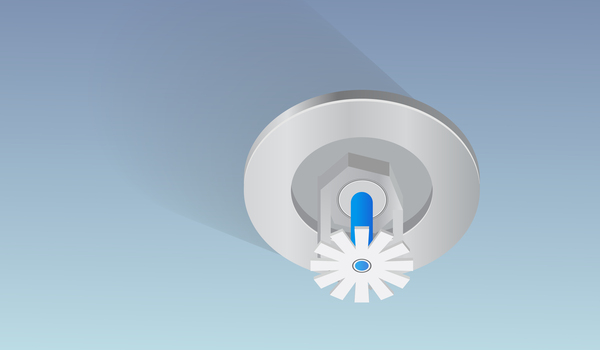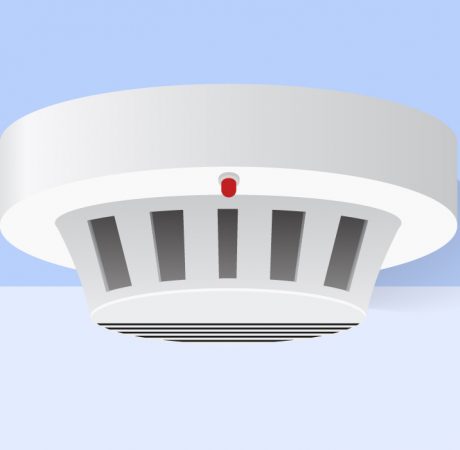Comparison Guide
What is the difference between active and passive fire protection?
Fire protection is separated into two categories: active and passive. Each system offers a distinct approach to fire protection, but both are vital in ensuring the highest standards of fire safety are met. This article will be highlighting the differences between active and passive fire protection.

What is active fire protection?

Active fire protection is a system of equipment and components that safeguards through action.
Active fire equipment possess an active state and a latent state. A manual or automatic trigger is required to activate the equipment, bringing it out of its latent state and into its active state. Once active, these components aim to eliminate the blaze. This may be achieved indirectly, such as an alarm alerting people of the fire and prompting them to take action, or directly, by releasing a liquid or foam that attempts to extinguish the blaze.
Active fire protection in its latent state offers no defence against fire. A sprinkler with dead batteries, or an extinguisher that is never squeezed, offer no protection against an ongoing fire. It is only when they are activated as a result of a trigger that protection is provided.
What is passive fire protection?

A Passive fire protection is the components of a building's structure that reduce or prevent the movement of fire.
Passive fire protection does not seek to extinguish a blaze, merely to prevent it from spreading and causing further harm. This is achieved through compartmentalisation and fire-resistant materials.
Manual Vs Automatic Fire Protection
Manual
-
![Fire extinguishers]() Fire extinguishers Squeezing the handle shoots chemicals or other substances into the fire.
Fire extinguishers Squeezing the handle shoots chemicals or other substances into the fire.
-
![Fire blankets]() Fire blankets Blankets are thrown over the fire to smother it.
Fire blankets Blankets are thrown over the fire to smother it.
-
![Wet/dry risers]() Wet/dry risers Pipes attached to sprinkler systems that douse the fire when handle is turned.
Wet/dry risers Pipes attached to sprinkler systems that douse the fire when handle is turned.
Automatic
-
![Fire alarms/smoke alarms]() Fire alarms/smoke alarms Loud sounders are activated when smoke or heat is detected.
Fire alarms/smoke alarms Loud sounders are activated when smoke or heat is detected.
-
![Fire suppression systems]() Fire suppression systems A combination of dry chemicals and/or wet agents are deployed upon heat detection.
Fire suppression systems A combination of dry chemicals and/or wet agents are deployed upon heat detection.
-
![Sprinkler Systems]() Sprinkler Systems Automatic sprinkler systems detect smoke or heat and release water.
Sprinkler Systems Automatic sprinkler systems detect smoke or heat and release water.
-
![Foam suppression systems]() Foam suppression systems Foam is released upon fire detection to separate flame from fuel.
Foam suppression systems Foam is released upon fire detection to separate flame from fuel.
Examples of passive fire protection:

Air sealing
Reduces the amount of oxygen that leaks into a room.

Cable coatings
Rire protection coating protects electrical cables.

Coatings
Fire protection coating for walls and other applications.

Compartmentation
Strategic structural placement prevents a fire spreading.

Fire dampers
Prevents fire spreading through ventilation and air conditioning ducts.

Fire doors
Possess fire-resistant materials and coatings that prevent the door from setting alight.

Fire-resistant glass
Glass remains intact and prevents fire from spreading.

Insulation
Protects the structural frame of the building.
What is the difference between active and passive fire protection?

In summary, the differences between active and passive fire protection are as follows:
- Active fire protection aims to detect, alert, or extinguish the fire directly. Passive fire protection aims to compartmentalise an area and prevent the fire from spreading.
- Active fire protection has a latent state and an active state. A manual or automatic trigger is needed to switch the system from latent to active. Passive fire protection has one constant state.
Should I use active or passive fire protection?
Active fire protection and passive fire protection work in tandem. Both types of fire protection should be implemented in every establishment to ensure the maximal levels of fire safety.
When a fire occurs, the smoke or heat from the blaze will trigger the fire alarm system. The fire alarm system becomes active and instantly communicates with multiple components. The sounder is triggered, emitting a loud noise to alert people of the fire. Once alerted, people can take suitable action, including tackling the blaze themselves with a fire extinguisher, calling the emergency services, or evacuating. Sprinklers will also be triggered, raining down water in an attempt to extinguish the flame.
Simultaneously, the fire-resistant walls will be preventing the fire from spreading, giving the active fire protection the best chance to tackle the flame. Fire doors, in addition to participating in compartmentalising certain areas, will enable alerted inhabitants to evacuate safely.
Scutum London supplies a wide range of active and passive fire protection systems and equipment to customers throughout London, Surrey and the wider South East, from monitored fire alarm systems and glazed fire doors to fire risk assessments and basic fire training.
Contact us now to find out more or to arrange a free site visit to assess your business premises.
![Elite Logo]() Help & Advice
Help & Advice
How to Reset a Pyronix Enforcer Alarm System After a Power Cut
How to Add a Pyronix Wireless Fob to a Pyronix Wireless Alarm System
Is it Illegal to Not Have Interlinked Smoke Alarms?

Fire Emergency Response Planning: Preparing Your Business

Latest Trends in Fire Detection Technology









